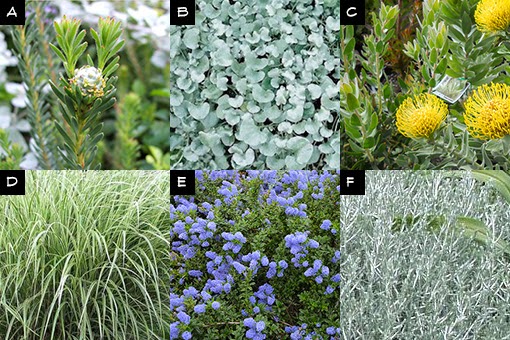I came across Banksia speciosa at San Francisco Botanical Garden earlier this month. And, I was happy to see it on the Devil Mountain Nursery website, so I'm hoping it is somewhat available. It has gorgeous gray green leaves, with zigzagging serrated edges. At the ends of each branch, in the center of its radiating leaves, this plant produces a cone-shaped flower. Together, the geometries are something to marvel at and from which to derive architectural inspiration, much like Frank Lloyd Wright would have done.
Like the other plants in the Proteaceae family, this plant can get very large (20' h x 15' w), which is much too big for most residential gardens (wouldn't it be great if there were a smaller cultivar??). The irony is that this would make a great freeway screening plant, but I feel its beauty is only fully appreciated close-up.
Mixing things up a bit, this planting scheme is based more on form than color. This could be a part of a mature garden, for the hypothetical 'Banksia House'. A) Banksia speciosa, can be accompanied by other thin leafed plants such as C) Yucca rostrata, and E) Butia capitata, as well as broad leaved plants such as B) Agave celsii var. albicans 'UCB' (seen on San Marcos Growers website), D) Leucadendron discolor 'Pom Pon', and F) Aloe plicatilis. Assuming the Banksia House is on plenty of land, these plants would look amazing massed together, basking in the hot Southern California sun.
Details:
Biological Name: Banksia speciosa
Common Name: Showy Banksia
Family: Proteaceae (Proteas)
Origin: Australia (Australasia)
Exposure: Full Sun
Irrigation: Low Water Needs
Flower Time: Summer/Fall
Height: 12-20’
Width: 10-15’


















































